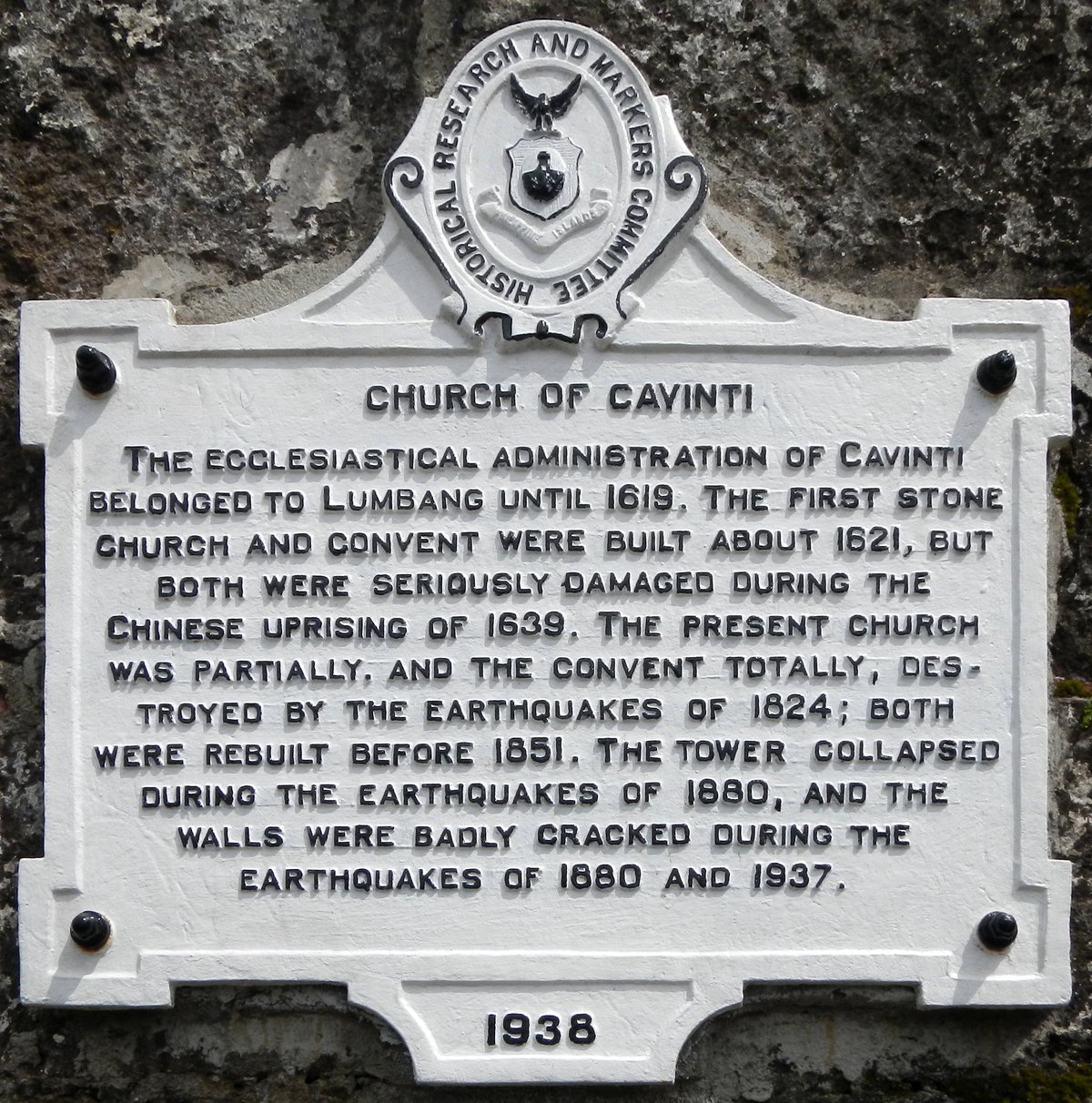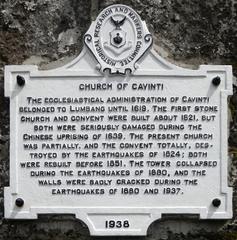
Church of Cavinti Historical Marker: Visiting Hours, Tickets, and Travel Guide
Date: 14/06/2025
Introduction
Nestled in the vibrant municipality of Cavinti, Laguna, the Church of Cavinti—officially the Transfiguration of Our Lord Parish Church—stands as a monumental witness to centuries of faith, resilience, and communal spirit in the Philippines. Established as an independent parish in 1619, the church beautifully exemplifies Spanish colonial architecture interwoven with local Filipino craftsmanship. Throughout its existence, it has weathered natural disasters, social upheavals, and witnessed countless religious festivities, making it a living landmark of both spiritual and historical importance (Wikipedia: Cavinti Church; NHCP Historic Sites).
This guide offers a comprehensive overview of the church’s history, cultural significance, practical visitor information, and tips for maximizing your visit. Whether you’re a pilgrim, history enthusiast, or casual traveler, discover everything you need to know about the Church of Cavinti and its celebrated historical marker (TravellingPeoples.com; Audiala; Mapcarta).
Table of Contents
- Introduction
- Early Foundations & Ecclesiastical Origins
- Architectural & Historical Development
- Restoration and Heritage Recognition
- Religious and Cultural Relevance
- Visiting Hours, Tickets, and Accessibility
- Visitor Experience and Etiquette
- Nearby Attractions & Suggested Itineraries
- Preservation Efforts & Community Involvement
- Frequently Asked Questions (FAQ)
- Conclusion
- References
Early Foundations & Ecclesiastical Origins
The Church of Cavinti traces its beginnings to the Spanish colonial era, when Cavinti was under the ecclesiastical jurisdiction of Lumban. It became an independent parish in 1619, following a papal bull from Rome (Wikipedia: Cavinti Church; Audiala). Early structures were constructed from local, temporary materials, reflecting the humble resources of the first settlers.
A local legend tells of the Puhawan brothers, who, while hunting, discovered a sacred image of El Salvador. After the image repeatedly vanished and reappeared at the same site, the event was interpreted as a divine sign to build the church there (Village Pipol).
Architectural & Historical Development
Stone construction began in 1621 under Pedro de San Martin, and the church soon included an adjacent convent. The church faced significant challenges, including destruction during the 1639 Chinese uprising and damage from major earthquakes in 1824 and 1880. The bell tower, built between 1822 and 1831, was destroyed and rebuilt several times. Despite these setbacks, restoration efforts have preserved the church’s unique blend of Spanish colonial and local architectural features (Wikipedia: Cavinti Church).
Restoration and Heritage Recognition
The National Historical Commission of the Philippines (NHCP) has officially recognized the Church of Cavinti for its cultural and historical significance, installing a commemorative marker at the site (NHCP Historic Sites). This marker succinctly details the church’s foundation, its reconstruction following calamities, and its enduring role in the religious and cultural life of Cavinti.
Religious and Cultural Relevance
Dedicated to Señor del Trasfiguracion or El Salvador del Mundo, the church is central to Cavinti’s spiritual life. The annual feast of the Transfiguration (August 6) is celebrated with vibrant processions and community gatherings. The church also honors Our Lady of Snows and Saint Joseph as secondary patrons. Its role in local traditions, rites of passage, and festivals cements its place as the heart of Cavinti’s religious community (Village Pipol).
Visiting Hours, Tickets, and Accessibility
- Visiting Hours: 7:00 AM to 6:00 PM daily. During special events or holidays, please confirm with the parish office or official tourism channels.
- Entrance Fee: There is no entrance fee; donations to support preservation are appreciated.
- Accessibility: The church grounds are generally accessible, with some ramps available. Certain areas may have uneven paths typical of heritage sites. Visitors with mobility needs should contact the parish in advance for assistance.
- Parking: Limited parking is available nearby. Public transportation (jeepneys, tricycles) is also accessible from Sta. Cruz or surrounding towns.
- Dress Code: Modest attire is recommended. Avoid sleeveless tops or shorts.
- Photography: Allowed, but please be respectful during services and ceremonies (Audiala; TravellingPeoples.com).
Visitor Experience and Etiquette
Upon arrival, visitors are greeted by the church’s imposing stone façade and tranquil grounds. The NHCP historical marker stands prominently, providing context for the church’s significance. Inside, intricate woodwork, antique altars, and religious icons offer a glimpse into centuries of devotion.
The church remains an active parish, hosting daily masses and annual festivals. Visitors are welcome to participate in services or observe religious rites, but maintaining a respectful and quiet demeanor is expected. During the annual feast or Holy Week, the church becomes a hub of cultural activity, with processions, music, and communal feasts.
For those interested in learning more, parish staff and volunteers are often available to share insights. Brochures or information boards may be found at the entrance. Interactive maps and virtual tours can sometimes be accessed via the parish’s website or local tourism portals.
Nearby Attractions & Suggested Itineraries
The Church of Cavinti is ideally located for exploring Laguna’s natural and cultural treasures:
- Pagsanjan Falls (Magdapio Falls): A short drive away, this iconic waterfall can be reached by boat from Pagsanjan or by hiking from Cavinti (Pagsanjan Falls Guide).
- Caliraya and Lumot Lakes: Popular for water sports, fishing, and scenic picnics.
- Cavinti Underground River and Caves: An emerging eco-tourism site with guided spelunking and river tours (Cavinti Tourism).
A typical day trip might include a morning visit to the church, lunch at a local eatery, and an afternoon adventure at one of Cavinti’s natural attractions.
Preservation Efforts & Community Involvement
The church’s ongoing preservation is a cooperative effort between local authorities, parishioners, and heritage organizations. The NHCP’s designation has boosted awareness and resources for maintenance and restoration. Community-led initiatives, often in partnership with the parish, keep the site vibrant and ensure its legacy for future generations (NHCP Historic Sites).
Frequently Asked Questions (FAQ)
Q: What are the visiting hours of the Church of Cavinti?
A: Daily from 7:00 AM to 6:00 PM.
Q: Is there an entrance fee or ticket required?
A: No entrance fee or ticket is required; donations are appreciated.
Q: Are guided tours available?
A: There are no daily formal tours, but parish staff or volunteers may offer information. Special tours are sometimes arranged during festivals.
Q: Is the site accessible for visitors with disabilities?
A: The grounds are generally accessible with ramps, though some uneven areas exist. Assistance is available upon request.
Q: What are other attractions nearby?
A: Pagsanjan Falls, Caliraya Lake, local markets, and artisan shops.
Conclusion
The Church of Cavinti, with its centuries-old architecture, storied past, and vibrant community life, offers an immersive journey into the spiritual and cultural heart of Laguna. With accessible visiting hours, free entry, and proximity to natural wonders, it is a must-see destination for any traveler or heritage enthusiast. Ongoing preservation efforts ensure that this landmark will continue inspiring future generations.
To enrich your Cavinti experience, plan your itinerary around the church, participate in local festivities, and support community initiatives. For the latest updates, events, and travel tips, consider downloading the Audiala app and following Cavinti’s tourism platforms.
References
- Wikipedia: Cavinti Church
- NHCP Historic Sites
- TravellingPeoples.com
- Audiala
- Mapcarta
- Village Pipol
- Scribd: History of Cavinti
- Laguna Tourism: Pagsanjan Falls Guide
- Cavinti Tourism
